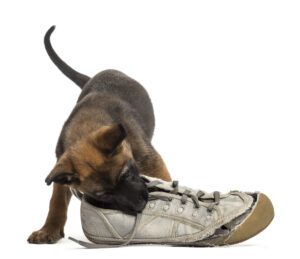Folks have a tendency to conflate dog training methods and equipment. I frequently get inquiries from people who have never trained a dog and want to know what ‘methods’ I use.
I use dog training methods that work. Are they ‘humane’? Certainly. Are they ‘positive’? I’d like to think so.
The goal, I think, should be to get the issue resolved, in an efficient manner, yielding reproducible results, in a way that is mutually beneficial to the dog and to the end-user.
Trainers usually don’t start out with combative training. If they do, they aren’t what I’d consider to be very good trainers. That’s not a tool issue or even a method issue. That’s just a common sense issue.
The only tool I rely on is the grey mush between my ears since every dog is different, and each one requires a nuance of application that can only be achieved through knowledge and experience.
One size does not fit all.
I use a thorough outline that renders results on many different personalities, ages, breeds, and behaviors. I follow this formula because I handle many dogs, and I have found that having a plan reaps far more predictable results than approaching things haphazardly.
The tools I use may vary, depending on the dog at my feet, the goals for training, and who that dog will be going home to.
The tools someone in another discipline would use, are being used for the same reasons I would not, with a pet dog. Performance dog trainers want to increase a specific response to stimuli that the companion animal trainer wants to suppress.
Allowing a dog the latitude to pull into defense and prey are two primary things pet owners are trying to stop, not exploit. Demonstrating it is easy. Explaining to a pet dog owner how and why it’s happening in ways that can translate into a resolution is where the talent lies.
It’s no great revelation that the methodology used within any discipline has more similarities than differences to another. It’s the *goal* that matters. None of this was created out of whole cloth, nor was it ‘discovered’ recently. It has been a facet of how dogs learn for many many years.
There really is nothing new under the sun, only new to folks that are seeing something for the first time.
It all starts with selection, but that is a conversation I have initiated more than once, here. If a person acquires a dog of a certain breed, there can be a reasonable expectation that some of those behaviors are genetic, and are specific to the breed.
Livestock guarding dogs guard. That is their purpose. The best you can expect from one as a companion is indifference, and a high probability of defensive behavior behind barriers, within homes, on properties, etc., because it is by design.
I don’t care how far removed from a performance breeding program that individual is, or lack of suitability for work on a 6 thousand acre spread in Montana, there is still vestigial behavior, and it will manifest in that suburban home, on those suburban streets, behind those suburban picket fences.
Same with any of the guardian breeds.
Herding breeds herd. There are associated behaviors that accompany those genetics. Same with retrievers. Terriers dig. Nordic breeds howl and do other stuff that are diametrically opposed to peaceful existence as a companion animal.
So before you asks “what methodology do you use”, maybe consider the type of dog you own, and what the problems you are experiencing are.
The first choice an owner must ‘own’, is if the dog they chose to be their companion is suitable as such?


